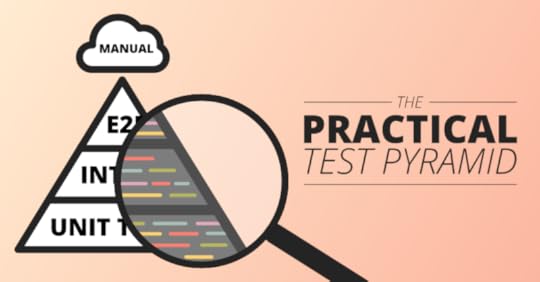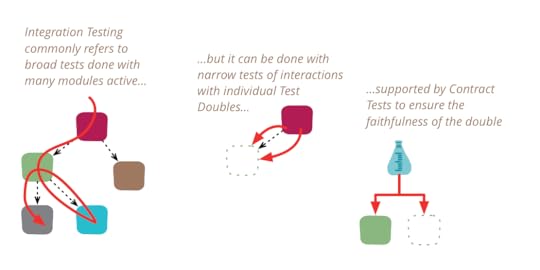Martin Fowler's Blog, page 20
March 5, 2018
What I Talk About When I Talk About Platforms

Evan Bottcher has been involved with several of our clients with
microservices and platform building over the last few years. A couple of
years ago, at one of our radar writing meetings, he gave a great
presentation on what makes an effective way to think about platforms. We
urged him to turn it into an article, but for a long time he was too busy
to write it down. He talks about common un-platform problems, the danger
of backlog coupling, and the balance between autonomy and efficient use of
infrastructure.
March 3, 2018
photostream 113
March 1, 2018
Completing the Pyramid

Ham completes his article on showing how to use test pyramid in
practice by looking at acceptance tests and exploratory testing. He also
finishes with a few words on pipelines and the need to avoid duplication
in testing between the layers of the pyramid.
February 26, 2018
UI and End-to-End tests

The whole point of the test pyramid is to remind us that broad scope
tests should be rare, since they are usually expensive and slow. Rareness
isn't the same as absence, so now Ham takes a look at role of UI tests and
end-to-end testing in general.
February 22, 2018
Contract Tests Ensure Faithful Doubles

Our approach to integration testing avoids hitting real services in
order to make testing easier and faster. But then a question rears up -
how do we know the test doubles for our integration tests are true doubles
of the collaborating service? Ham answers this question by discussing
Contract Tests and showing the role they play in his example application.
February 20, 2018
Integration Tests in the Pyramid

People find the notion of integration tests confusing, since they are
ill-defined even by the standards of testing terminology. So they are a
great topic for Ham's example application and explanation.
February 15, 2018
Unit Tests in the Pyramid

Ham now starts looking at the pyramid in earnest, beginning with the
foundation of the pyramid - unit tests.
February 14, 2018
The Practical Test Pyramid

The Test Pyramid has become a well-used part of software development.
But many people still struggle with how to use it in practice. My
colleague Ham Vocke has used it
in teaching several teams about effective testing and has gathered
together his experiences into an article that shows examples of different
kinds of tests applied to a simple sample application using Java and Spring Boot.
In this first installment he introduces the notion of the pyramid and
the structure of the sample application.
February 10, 2018
photostream 112
January 16, 2018
Bliki: IntegrationTest
Integration tests determine if independently developed units of software
work correctly when they are connected to each other. The term has become
blurred even by the diffuse standards of the software industry, so I've been
wary of using it in my writing. In particular, many people assume integration
tests are necessarily broad in scope, while they can be more effectively done
with a narrower scope.
As often with these things, it's best to start with a bit of history. When
I first learned about integration testing, it was in the 1980's and the
waterfall was the dominant influence of software development thinking. In a
larger project, we would have a design phase that would specify the interface
and behavior of the various modules in the system. Modules would then be
assigned to developers to program. It was not unusual for one programmer to be
responsible for a single module, but this would be big enough that it could
take months to build it. All this work was done in isolation, and when the
programmer believed it was finished they would hand it over to QA for
testing.
The first part of testing would be unit testing, which would test that
module on its own, against the specification that had been done in the design
phase. Once that was complete, we then move to integration testing, where
the various modules are combined together, either into the entire system, or
into significant sub-systems.
The point of integration testing, as the name suggests, is to test whether
many separately developed modules work together as expected. It was performed
by activating many modules and running higher level tests against all of them
to ensure they operated together. These modules could parts of a single
executable, or separate.
Looking at it from a more 2010s perspective, these conflated two different
things:
testing that separately developed modules worked together
properly
test that a system of multiple modules worked as expected.
These two things were easy to conflate, after all how else would you test
the frobile and twibbler modules without activating them both into a single
environment and running tests that exercised both modules?
The 2010s perspective offers another alternative, one that was rarely
considered in the 1980s. In the alternative, we test the integration of the
frobile and twibbler modules by exercising the portion of the code in frobile
that interacts with twibbler, executing it against a TestDouble of
twibbler. Providing the test double is a faithful double of twibber, we can
then test all the interaction behavior of twibbler without activating a full
twibbler instance. This may not be a big deal if they are separate modules of
a monolithic application, but is a big deal if twibbler is a separate service,
which requires its own build tools, environments, and network connections. For
services, such tests may run against an in-process test double, or against an
over-the-wire double, using something like mountebank
An obvious catch with integration testing against a double is whether that
double is truly faithful. But we can test that separately using ContractTests.
Using this combination of using narrow integration tests and contract
tests, I can be confident of integrating against an external service without
ever running tests against a real instance of that service, which greatly
eases my build process. Teams that do this, may still do some form of
end-to-end system test with all real services, but if so it's only a final
smoke test with a very limited range of paths tested. It also helps to have a
mature QA in Production capability, and if that is
mature enough, there may be no end-to-end system testing done at all.

The problem is that we have (at least) two different notions of what
constitutes an integration test.
narrow integration tests
exercise only that portion of the code in my service that talks to a
separate service
uses test doubles of those services, either in process or remote
thus consist of many narrowly scoped tests, often no larger in scope than a
unit test (and usually run with the same test framework that's used for unit
tests)
broad integration tests
require live versions of all services, requiring substantial test
environment and network access
exercise code paths through all services, not just code responsible for
interactions
And there is a large population of software developers for whom
“integration test” only means “broad integration tests”, leading to plenty of
confusion when they run into people who use the narrow approach.
If your only integration tests are broad ones, you should consider
exploring the narrow style, as it's likely to significantly improve your
testing speed, ease of use, and resiliency. Since narrow integration tests are
limited in scope, they often run very fast, so can run in early stages of a
DeploymentPipeline, providing faster feedback should they go
red.
All this is why I'm wary with “integration test”. When I read it, I look
for more context so I know which kind the author really means. [1] If I talk about
broad integration tests, I prefer to use “system test” or “end-to-end test”. I
don’t have any better name for narrow integration tests, so I do use that (but
with “narrow” to help signal to the reader the nature of these tests).
Acknowledgements
Birgitta Böckeler, Brian Oxley, Dave Rice, Deepti Mittal, Jonny Leroy, Kief Morris, Raimund Klein, Rogerio Chaves, and Tiago Griffo
discussed drafts of this post on our internal mailing list.
Notes
1:
Although I prefer to focus the definition on the interaction of separately
built modules, I do occasionally see “integration test” used to mean anything
bigger than a unit test. And for some users of solitary unit tests, I’ve
seen them describe sociable unit tests as “integration tests”.
Share:



if you found this article useful, please share it. I appreciate the feedback and encouragement
Martin Fowler's Blog
- Martin Fowler's profile
- 1103 followers





